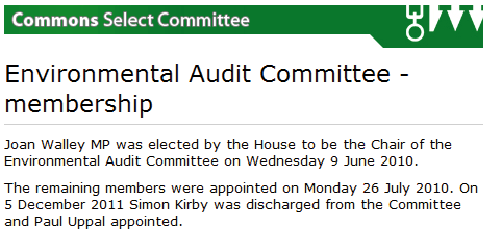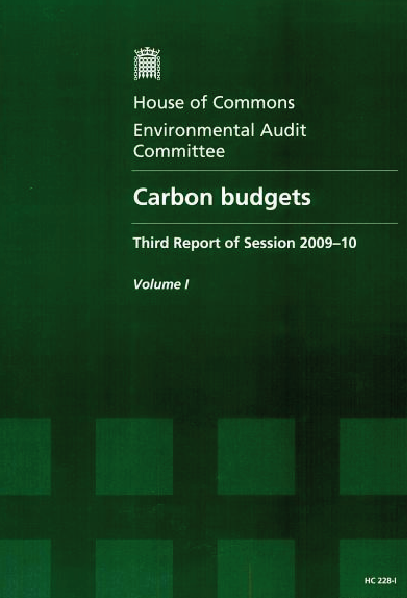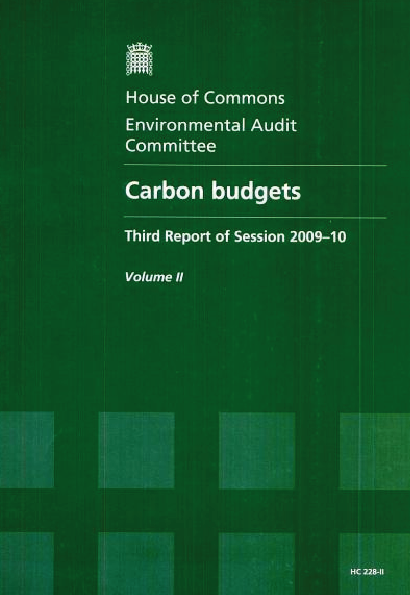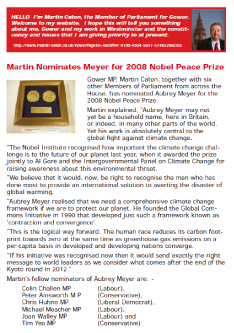Back to UNFCCC Submission Back to Signatory List
Aubrey
Thanks for your email.
I wish you to add my name in support.
Joan Walley MP
Chair Environmental Audit Committee UK House of Commons"In the UK Climate Act we have endorsed the C&C principle.
Its pretty strong support for what Aubrey Meyer has said."
The Chairman of the UK Climate Change Committee Adair Turner
Interogated by Joan Wally MP, confirms to EAC that C&C is embedded in UK Climate Act
The Global Commons Institute said that the origins of the advice from the Committee on Climate Change
could be traced back to the Royal Commission on Environmental Pollution’s advocacy of contraction & convergence in their report ‘Energy—the Changing Climate’ published in 2000.52 The Global Commons Institute promotes contraction and convergence as a means of resolving the impasse in international negotiations. Contraction and convergence is a framework for reducing global emissions of greenhouse gases that envisages global emissions peaking and then gradually falling (contraction). It achieves the reduction in emissions by limiting per capita emissions in such a way that they converge (convergence). It entails large cuts in per capita emissions for developed countries while allowing developing countries to continue growing their economies before they have to make cuts to reach equal per capita emissions. Lord Turner said that the advice of the Committee on Climate Change was, “reasonably pragmatically close to Contraction and Convergence”.
Carbon Budgets Volume 1
House of Commons: Environmental Audit Committee
Question: - Where did the UK budgets come from? Are they adequate to keep within the 2 degree limit?
- The UK budgets came from Contraction and Convergence via the Royal Commission on Environmental Pollution [RCEP] 2000 report “Energy—The Changing Climate”. The report recommended C&C but applied it at rates that are too slow to keep within the 2 degree limit.
- To keep within the 2 degrees Celsius temperature limit, the budgets need to be based on a global emissions contraction of 80% by 2050 and where the airborne fraction may still stay constant @ 50% giving a 450 ppmv outcome. But with sinks failing @ 0.5%/yr, the outcome only may still be 450ppmv.
- By not taking account of the “new” Coupled-Carbon-Cycle modelling in IPCC AR4 Chapter 10 [2007], the UK Climate Change Committee models and the assumptions used by the Committee on Climate Change are not valid in setting carbon budgets.
- There is unanimous agreement among the coupled climate carbon cycle models driven by emission scenarios run so far that future climate change would reduce the efficiency of the Earth system (land and ocean) to absorb anthropogenic CO2. There is evidence that the CO2 airborne fraction is increasing, so accelerating the rate of climate change.
- Until about 1800 the overall climate system was at equilibrium. The very sudden rise of the atmospheric concentration of CO2 and CH4 since then shows that the system is no longer in conditions of homeorhesis, it is going out of control.
- JokeWaller Hunter, Executive Secrearty of the UNFCCCCOP-9 in Milan in 2003 said, “Achieving the goal of the United Nations Framework Convention on Climate Change inevitably requires contraction and convergence.”
- The basis on which the UK Committee on Climate Change arrived at the UK’s share of the global effort to cut emissions was the RCEP and their advocacy of Contraction and Convergence.
- Convergence to equal per capita emissions entitlements globally for example by 2020, would reflect the C&C principle where, “if contraction must be accelerated for reasons of urgency, convergence must be accelerated relative to that for reasons of equity.”
- There appears to be an emerging consensus for Contraction and Convergence as the UNFCCC-compliant global framework for climate mitigation, as evidenced in the reference material attached to this memorandum.
- There is real danger of not doing enough soon enough to avoid dangerous rates of climate change.
- But with sinks failing @ 0.5%/yr, the outcome only may still be 450ppmv.
- In concert with others, the UK Government’s aim is to limit overal global temperature above pre-industrial to no more than two degrees Celsius. Not exceeding 450 ppmv CO2 in the atmosphere is considered a pre-requisite of keeping within that limit.
- “Enforcing” the right target will be no harder than enforcing the wrong target.
Carbon Budgets Volume 2 - the evidence
House of Commons: Environmental Audit Committee
Nomination - but not winner - of Aubrey Meyer for the 2008 Nobel Peace Prize
by Martin Caton, and six other Members of Parliament from the UK House of Commons
Martin’s fellow nominators were Colin Challen MP (Labour), Peter Ainsworth MP (Conservative), Chris Huhne MP (Liberal Democrat), Michael Meacher MP (Labour), Joan Walley MP (Labour) and Tim Yeo MP (Conservative).Martin explained, “Aubrey Meyer may not yet be a household name, here in Britain, or indeed, in many other parts of the world. Yet his work is absolutely central to the global fight against climate change.“ The Nobel Institute recognised how important the climate change challenge is to the future of our planet last year, when it awarded the prize jointly to Al Gore and the Intergovernmental Panel on Climate Change for raising awareness about this environmental threat. “We believe that it would, now, be right to recognise the man who has done most to provide an international solution to averting the disaster of global warming.“ Aubrey Meyer realised that we need a comprehensive climate change framework if we are to protect our planet. He founded the Global Commons Initiative in 1990 that developed just such a framework known as ‘contraction and convergence’. “This is the logical way forward. The human race reduces its carbon footprint towards zero at the same time as greenhouse gas emissions on a per capita basis in developed and developing nations converge. If his initiative was recognised now then it would send exactly the right message to world leaders as we consider what comes after the end of the Kyoto round in 2012.”





